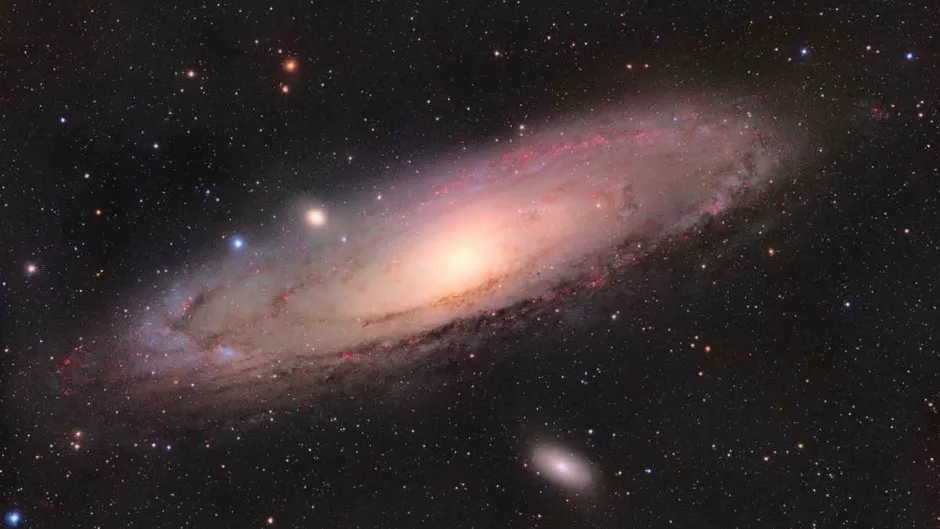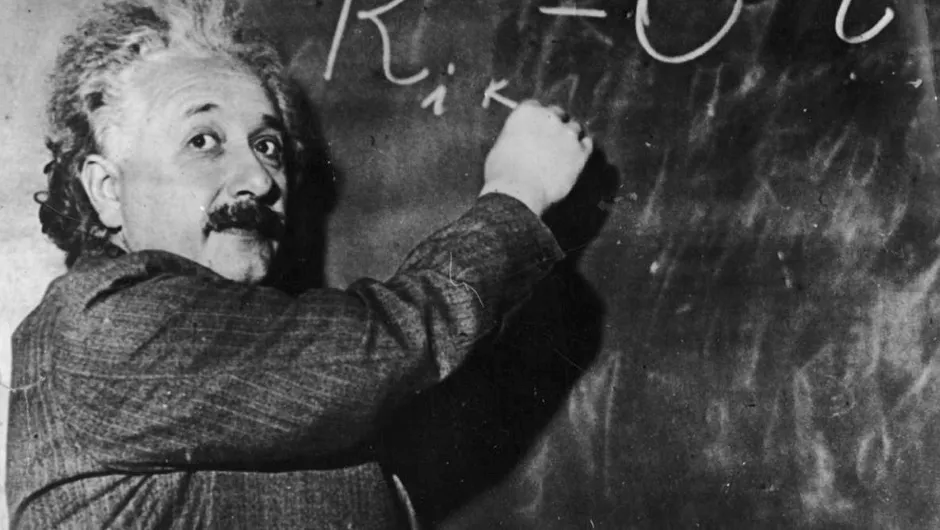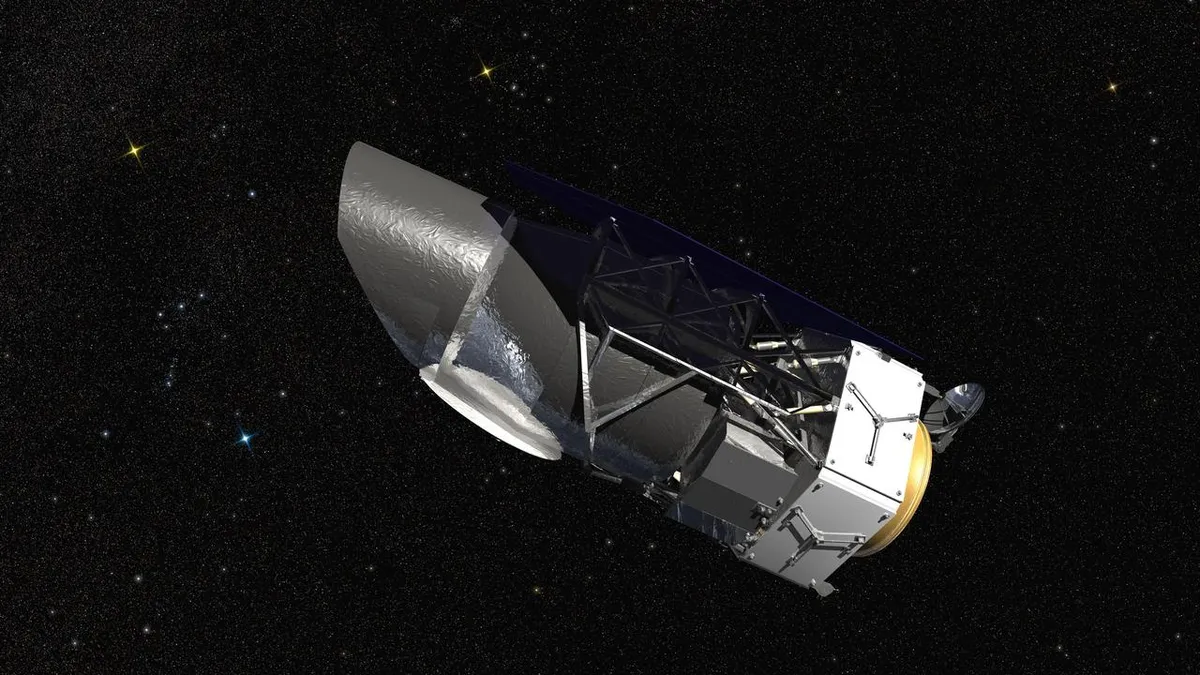A little under 14 billion years ago, our Universe winked into existence in a momentous event known as the Big Bang. Where previously there was nothing – no matter, no energy, not even space and time as we know them – suddenly there appeared the superheated embryo from which the present-day Universe grew.
Today, the space of our Universe is immense. When astronomers peer out at the night sky through their telescopes, the furthest galaxies they see are many billions of light-years distant. Space reached these staggering proportions for one simple reason – namely, it’s expanding. This expansion was predicted by Albert Einstein’s General Theory of Relativity (even though Einstein initially rejected the notion) and was later discovered in 1929 by the American astronomer Edwin Hubble and his assistant Milton Humason.
The race was then on to figure out just how fast expansion is happening. This would determine key properties of our Universe, such as its age, how large-scale structures such as galaxies formed and, perhaps most important of all, how the Universe might ultimately end its days. The inward gravitational pull of a slowly expanding Universe will eventually halt the expansion and cause space to recollapse, literally falling back in on itself and imploding in a kind of inverse big bang that’s been dubbed the Big Crunch.
It’s rather like a ball hurled up into the air, which must eventually answer to the force of gravity and fall back to the ground. But throw the ball into the air much faster and it can escape the planet’s gravity. A rapidly expanding Universe would behave in much the same way, the expansion continuing forever – leading to an eternal Universe, albeit an increasingly diluted one as the galaxies are stretched across an ever-increasing volume of space.
And yet the longer astronomers stared through their telescopes, the clearer it became that a simple matter-filled Universe expanding under the action of gravity didn’t match up with observations.

For starters, it seemed that there was more material out in space than simply adding up all the bright, visible stuff could account for. In the 1930s, astronomers investigating clusters of galaxies found that some of the galaxies in a cluster appeared to be moving so fast that they should be able to escape the cluster’s gravity. The simple fact that the galaxies weren’t all flying off into space meant there must be enough gravity in the cluster to hold them all together as a bound system – but there didn’t seem to be enough matter present to do this.
Later, in the 1970s, studies found the exact same discrepancy within individual galaxies and then in the Universe at large, suggesting that anywhere between 50 and 95 per cent of the material in the Universe was made of this mysterious invisible stuff – which was christened ‘dark matter’. No one was sure quite what it is (and that’s still the case today), though of one thing they were sure – all the extra gravity of this missing matter looked set to put the brakes on cosmic expansion.
But things were set to get a whole lot stranger. By the mid-1990s, growing discord between astronomical observations and theoretical calculations was leading astrophysicists to believe that dark matter wasn’t the only hidden component of the Universe. And in 1998, these suspicions were confirmed. Two teams of astronomers, working independently, found that the expansion of the Universe isn’t being slowed down by gravity at all. In fact, quite the reverse – it’s accelerating.
This inference was made from studies of supernovae – immense explosions each marking the death of a massive star. They are extraordinarily bright, briefly outshining the light from all the stars in their host galaxy combined – which makes them perfect for cosmology, where observational targets need to be visible from billions of light-years away.
In particular, the astronomers looked at a class of supernovae known as type 1a (which occur in binary star systems – pairs of stars in orbit around one another). These are special because the duration of the supernova fireball can be linked by a formula to their intrinsic brightness. And that means that measuring their apparent brightness as seen from Earth reveals how much their light has been dimmed with distance, and thus how far away they and their host galaxies actually are.
The finite speed of light means that galaxies far away in the distance are seen as they were far back in time. Studying a galaxy billions of light-years from Earth thus gives astronomers a snap-shot of what the Universe was like billions of years in the past. And this enabled the two teams of astronomers to build up a picture of how the expansion has changed with time over cosmic history. Their findings clearly showed that the expansion rate was steadily increasing as the Universe grew older.

But what could be causing it? Physicists were quick to come up with a name – ‘dark energy’ – though figuring out exactly what it’s made of was another matter altogether. Einstein had put forward the best suggestion. He said that the Universe was pervaded by what he called a ‘cosmological constant’ (so named because it manifested as a constant term in the equations of general relativity), which generated the exact same acceleration effect seen in the supernova observations. This was back when Einstein was trying to ‘remedy’ general relativity’s prediction that space is expanding – the acceleration was exactly what he needed to cancel out gravity and hold the Universe static. But when Hubble and Humason’s discovery that space is expanding broke he quickly consigned the cosmological constant to the bin.
Quantum physicists – scientists who study the behaviour of subatomic particles of matter – have calculated that a cosmological constant-like effect should arise from the vacuum of empty space. Quantum theory predicts that the vacuum is filled with ‘virtual particles’ popping in and out existence over very short timescales. And the resulting ‘vacuum energy’ that all these ghostly particles create, when plugged into the equations of general relativity, leads to a cosmic acceleration effect that could explain dark energy. The problem, however, is that the amount of dark energy predicted from quantum theory is very much larger than observations permit.
Another possibility is that dark energy is the product not of empty space itself, but of a field of matter or energy filling space. In this framework, the dark energy wouldn’t be constant but would evolve dynamically as the Universe expanded. Cosmologists have coined the term ‘quintessence’ to describe the field of matter driving models such as this, a reference to the fifth of the classical elements from which the ancient Greek philosophers believed the Universe to be composed.
Quintessence is appealing because it could help to resolve a problem in cosmology that has emerged recently, whereby present-day measurements of the cosmic expansion rate are significantly larger than estimates obtained by taking measurements of the young Universe and evolving them forward in time using the best cosmological models. One solution is a quintessence-like model in which not only is the expansion of the Universe accelerating but the rate of acceleration is accelerating too – that is, cosmic acceleration is increasing with time. The extra acceleration that this exotic variety of dark energy, known as ‘phantom energy’, generates would boost cosmic expansion, bringing it into line with observations.

Because dark energy is causing the expansion of the Universe to accelerate, rather than pulling it back in on itself, it seems likely that a Universe playing host to this stuff will continue to expand for eternity, ruling out the possibility of a Big Crunch. Though a time-varying quintessence field could change all of this, perhaps allowing the Universe to recollapse in the future even though it’s doing the complete opposite now.
More astronomical observations are needed, and there are several projects planned to explore the nature of dark energy further. In 2020, the Large Synoptic Survey Telescope (LSST), in Chile, will begin a 10-year study of distant galaxies. Also that year, the European Space Agency is due to launch its Euclid space telescope. And in the mid-2020s NASA launches its own space observatory, the Wide Field Infrared Survey Telescope (WFIRST). Current estimates of the nature of dark energy confirm that it behaves like Einstein’s cosmological constant to within an accuracy of 10 per cent. Euclid, WFIRST and the LSST will tighten this up to around 3 per cent – or, perhaps more interestingly, they may uncover evidence showing that dark energy is a different animal altogether. We’ll just have to wait and see.
Today, the evidence for the existence of dark energy is fairly ironclad. The best observations suggest that it makes up 69 per cent of our Universe. Around 26 per cent is dark matter, while atoms and molecules – the stuff that stars and planets, and you and I, are made from – accounts for a rather paltry 5 per cent. In 2011, the astronomers who made the breakthrough supernova observations confirming its existence were awarded the Nobel Prize in Physics.
Dark energy is central to so much of what we don’t understand in cosmology. Cracking this enigma will tell us what the lion’s share of the Universe is made from, it may reveal new details about fundamental particle physics, it will probably yield clues to the nature of the Big Bang, and it’ll almost certainly determine how the Universe will finally die.
And that’s why cracking this enigma remains one of the most urgent priorities for cosmologists in the 21st Century.
The Beginning and the End of Everything: From the Big Bang to the End of the Universe byDr Paul Parsons is available now (£16.99, Michael O'Mara)
Follow Science Focus onTwitter,Facebook, Instagramand Flipboard
